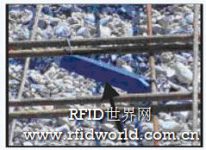
RFID technology has been successfully applied in wireless monitoring of concrete maturity
[ad_1]
The measurement of concrete maturity has always been an urgent problem to be solved. How to quickly and easily measure the maturity of concrete has become the focus of many people in the construction industry.
The most widely used method is to plug a bunch of wires into a notebook and fix the box in cement to measure. This testing method is very inconvenient and has high consumption cost. Let IRD’s state-of-the-art technology help you do the job, IRD has built a system to help you wirelessly test the maturity of concrete using a handheld device. After the introduction of the IRD Concrete Maturity Monitoring System, the process of concrete maturity testing has been simplified into 3 easy-to-follow steps:
1. Locate the temperature monitoring label 2. Bury the label in the concrete 3. Record the information
The following figure shows the fixed schematic diagram of the temperature monitoring label:

The picture below shows a handheld PC communicating with a tag buried in concrete:

Wireless monitoring of concrete maturity using a handheld PC is that easy! Two-way RF communication is realized between the tag buried in the concrete and the handheld or laptop computer, which can read and write information interactively, so that the concrete monitoring of the IRD can reach the best level.
Technical advantages:
1. Affordable: low investment and quick recovery of costs
2. Wireless: Labels with temperature monitoring can collect data quickly and efficiently
3. No need to be visible: no need to fix the equipment on the ground to obtain concrete maturity information
4. Portable: Use the same handheld or laptop computer to monitor in multiple different locations
5. General purpose software: Very easy transfer of data from concrete monitoring software to software running on a laptop or handheld PC in Microsoft Office applications, or standard ASTM C1074 mode for typical projects, or for urgent work Quick mode. Graphical evaluation and comparison, with annotations for each individual tab. (Example: Concrete has been poured for an hour)
6. Maturity calculation method: The maturity calculation can use the equivalent age method and settable Q. For the special temperature maturity, the Nurse-Saul equation and a user-adjustable data temperature can be used.
7. Accuracy: The accuracy of temperature meets and exceeds the requirements of ASTM C1074-93. Expected concrete strength is based on field pressure testing rather than managed laboratory acquisitions.
8. Range: The standard monitoring tag can be read at a depth of 20.32cm, and the reading range extension tag can monitor temperature in an area deeper than 20.32cm
9. Low maintenance cost: the battery life of the temperature monitoring tag can reach 5 years
10. The software provided by Navis, including the upgrade software of SPARCS and the edge management middleware of Navis, connect the solution components, process data, and process data with the back-end SPARCS system.
System composition:
Each IRD concrete monitoring system includes the following components:
1. PCMCIA adapter
2. Concrete monitoring software
3. Portable computer, running Microsoft Pocket PC 2002 (optional)
4. Temperature monitoring labels (IRD uses IDENTECT SOLUTIONS production and patented iQ series labels)
6. The reading range extension label can be buried at any depth (depth optional).
The following figure shows the schematic diagram of “Handheld PC”

[ad_2]


